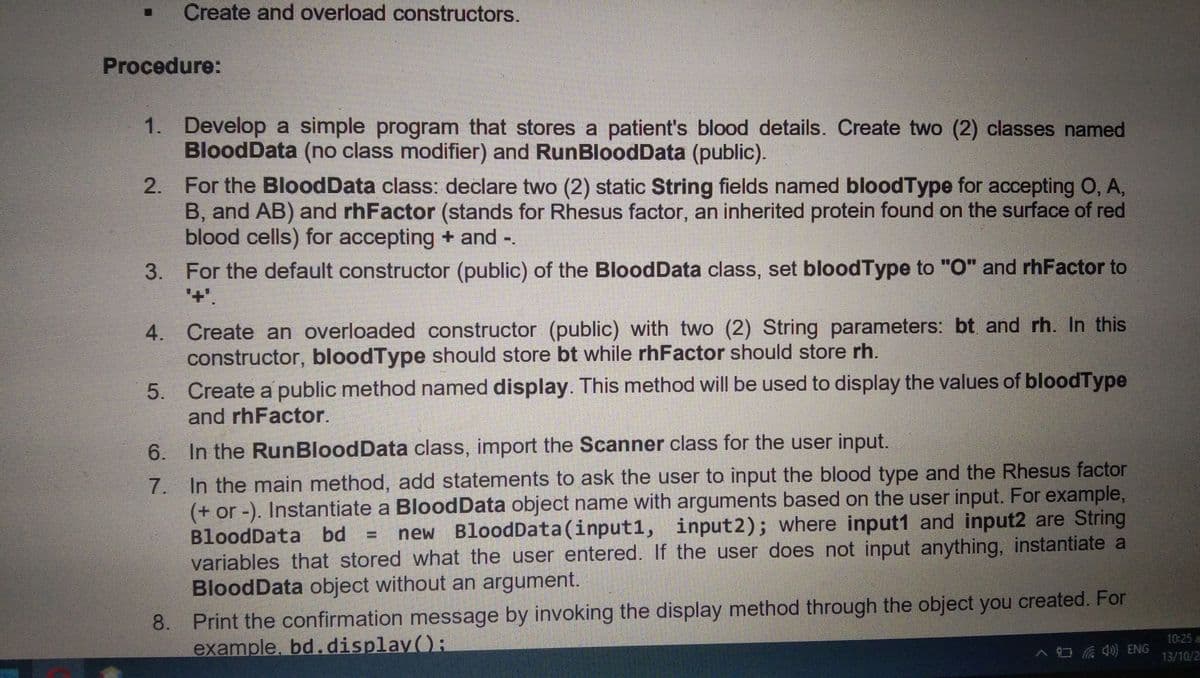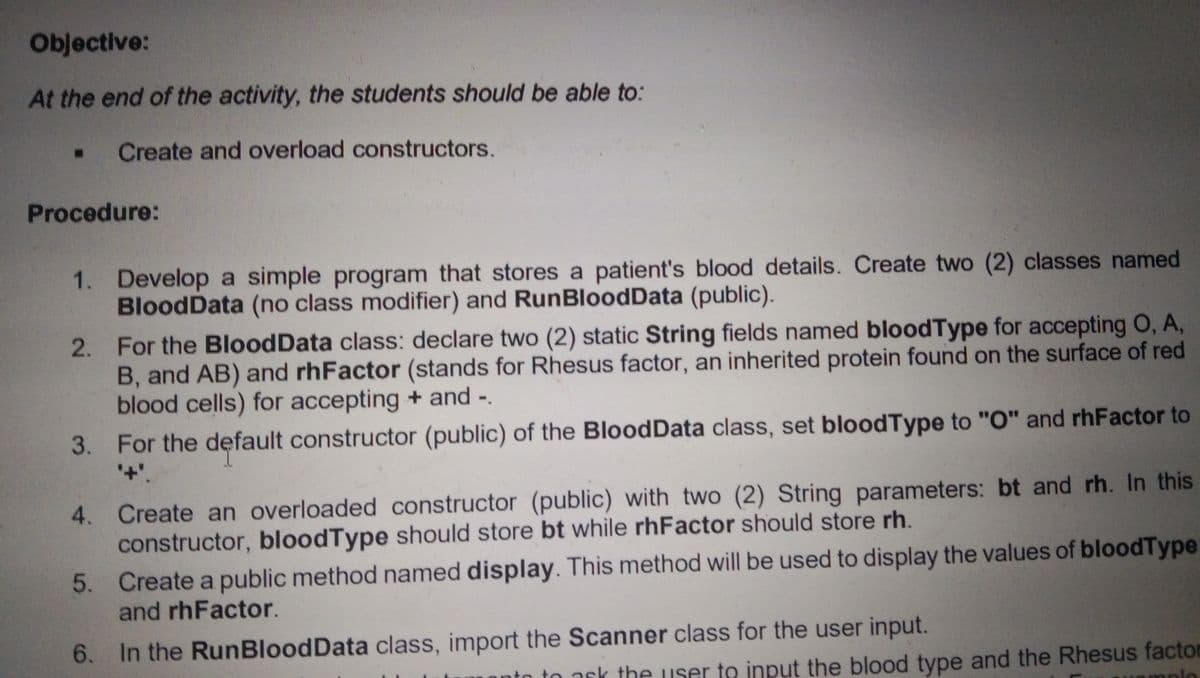Create and overload constructors. Procedure: 1. Develop a simple program that stores a patient's blood details. Create two (2) classes named BloodData (no class modifier) and RunBloodData (public). For the BloodData class: declare two (2) static String fields named bloodType for accepting O, A, B, and AB) and rhFactor (stands for Rhesus factor, an inherited protein found on the surface of red blood cells) for accepting + and -. 3. For the default constructor (public) of the BloodData class, set bloodType to "O" and rhFactor to 2. '+'. 4. Create an overloaded constructor (public) with two (2) String parameters: bt and rh. In this constructor, bloodType should store bt while rhFactor should store rh. Create a public method named display. This method will be used to display the values of bloodType 5. and rhFactor. 6. In the RunBloodData class, import the Scanner class for the user input. 7. In the main method, add statements to ask the user to input the blood type and the Rhesus factor (+ or -). Instantiate a BloodData object name with arguments based on the user input. For example, BloodData bd new BloodData(input1, input2); where input1 and input2 are String %3D variables that stored what the user entered. If the user does not input anything, instantiate a BloodData object without an argument. Print the confirmation message by invoking the display method through the object you created. For example, bd.display(): 8. 10 AO 40) ENG 131
Create and overload constructors. Procedure: 1. Develop a simple program that stores a patient's blood details. Create two (2) classes named BloodData (no class modifier) and RunBloodData (public). For the BloodData class: declare two (2) static String fields named bloodType for accepting O, A, B, and AB) and rhFactor (stands for Rhesus factor, an inherited protein found on the surface of red blood cells) for accepting + and -. 3. For the default constructor (public) of the BloodData class, set bloodType to "O" and rhFactor to 2. '+'. 4. Create an overloaded constructor (public) with two (2) String parameters: bt and rh. In this constructor, bloodType should store bt while rhFactor should store rh. Create a public method named display. This method will be used to display the values of bloodType 5. and rhFactor. 6. In the RunBloodData class, import the Scanner class for the user input. 7. In the main method, add statements to ask the user to input the blood type and the Rhesus factor (+ or -). Instantiate a BloodData object name with arguments based on the user input. For example, BloodData bd new BloodData(input1, input2); where input1 and input2 are String %3D variables that stored what the user entered. If the user does not input anything, instantiate a BloodData object without an argument. Print the confirmation message by invoking the display method through the object you created. For example, bd.display(): 8. 10 AO 40) ENG 131
Computer Networking: A Top-Down Approach (7th Edition)
7th Edition
ISBN:9780133594140
Author:James Kurose, Keith Ross
Publisher:James Kurose, Keith Ross
Chapter1: Computer Networks And The Internet
Section: Chapter Questions
Problem R1RQ: What is the difference between a host and an end system? List several different types of end...
Related questions
Question
Develop a simple program that store a patient's blood details using java.
Create two classes name bloodData and RunBloodData

Transcribed Image Text:Create and overload constructors.
Procedure:
1. Develop a simple program that stores a patient's blood details. Create two (2) classes named
BloodData (no class modifier) and RunBloodData (public).
2. For the BloodData class: declare two (2) static String fields named bloodType for accepting O, A,
B, and AB) and rhFactor (stands for Rhesus factor, an inherited protein found on the surface of red
blood cells) for accepting + and -.
3. For the default constructor (public) of the BloodData class, set bloodType to "O" and rhFactor to
'+'.
4. Create an overloaded constructor (public) with two (2) String parameters: bt and rh. In this
constructor, bloodType should store bt while rhFactor should store rh.
5. Create a public method named display. This method will be used to display the values of bloodType
and rhFactor.
6. In the RunBloodData class, import the Scanner class for the user input.
7. In the main method, add statements to ask the user to input the blood type and the Rhesus factor
(+ or -). Instantiate a BloodData object name with arguments based on the user input. For example,
BloodData bd
new BloodData(input1, input2); where input1 and input2 are String
variables that stored what the user entered. If the user does not input anything, instantiate a
BloodData object without an argument.
8. Print the confirmation message by invoking the display method through the object you created. For
example, bd.display();
10:25 a
13/10/2

Transcribed Image Text:Objective:
At the end of the activity, the students should be able to:
Create and overload constructors.
Procedure:
1. Develop a simple program that stores a patient's blood details. Create two (2) classes named
BloodData (no class modifier) and RunBloodData (public).
2. For the BloodData class: declare two (2) static String fields named bloodType for accepting O, A,
B, and AB) and rhFactor (stands for Rhesus factor, an inherited protein found on the surface of red
blood cells) for accepting + and -.
3. For the default constructor (public) of the BloodData class, set bloodType to "O" and rhFactor to
+'.
Create an overloaded constructor (public) with two (2) String parameters: bt and rh. In this
constructor, bloodType should store bt while rhFactor should store rh.
4.
5. Create a public method named display. This method will be used to display the values of bloodType
and rhFactor.
6. In the RunBloodData class, import the Scanner class for the user input.
sk the user to input the blood type and the Rhesus factor
aple
Expert Solution
This question has been solved!
Explore an expertly crafted, step-by-step solution for a thorough understanding of key concepts.
This is a popular solution!
Trending now
This is a popular solution!
Step by step
Solved in 4 steps with 4 images

Recommended textbooks for you

Computer Networking: A Top-Down Approach (7th Edi…
Computer Engineering
ISBN:
9780133594140
Author:
James Kurose, Keith Ross
Publisher:
PEARSON

Computer Organization and Design MIPS Edition, Fi…
Computer Engineering
ISBN:
9780124077263
Author:
David A. Patterson, John L. Hennessy
Publisher:
Elsevier Science

Network+ Guide to Networks (MindTap Course List)
Computer Engineering
ISBN:
9781337569330
Author:
Jill West, Tamara Dean, Jean Andrews
Publisher:
Cengage Learning

Computer Networking: A Top-Down Approach (7th Edi…
Computer Engineering
ISBN:
9780133594140
Author:
James Kurose, Keith Ross
Publisher:
PEARSON

Computer Organization and Design MIPS Edition, Fi…
Computer Engineering
ISBN:
9780124077263
Author:
David A. Patterson, John L. Hennessy
Publisher:
Elsevier Science

Network+ Guide to Networks (MindTap Course List)
Computer Engineering
ISBN:
9781337569330
Author:
Jill West, Tamara Dean, Jean Andrews
Publisher:
Cengage Learning

Concepts of Database Management
Computer Engineering
ISBN:
9781337093422
Author:
Joy L. Starks, Philip J. Pratt, Mary Z. Last
Publisher:
Cengage Learning

Prelude to Programming
Computer Engineering
ISBN:
9780133750423
Author:
VENIT, Stewart
Publisher:
Pearson Education

Sc Business Data Communications and Networking, T…
Computer Engineering
ISBN:
9781119368830
Author:
FITZGERALD
Publisher:
WILEY